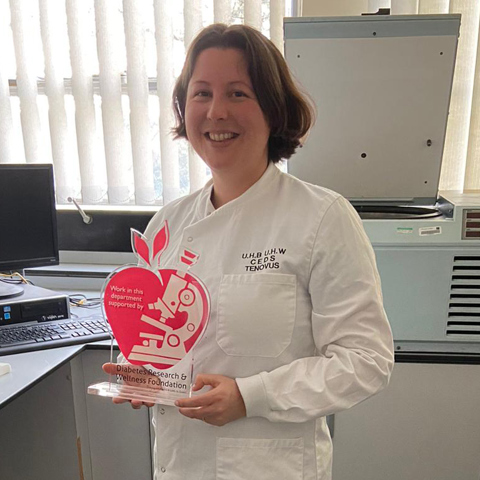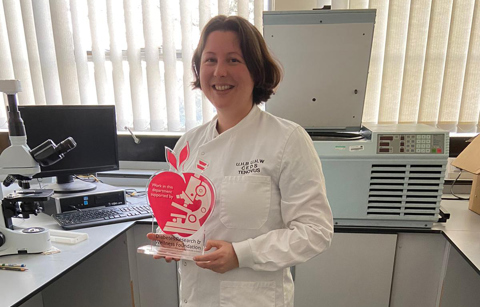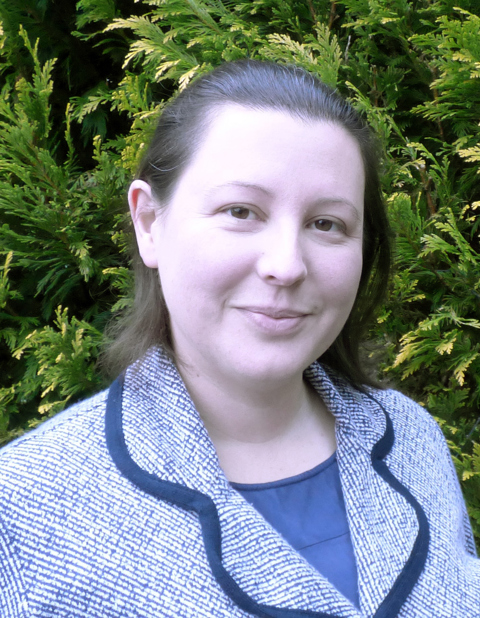
DRWF Research in focus: Severe insulin resistance in type 1 diabetes
Interview with Dr Stephanie Hanna, from Cardiff University, who was awarded the DRWF Professor David Matthews Non-Clinical Fellowship in 2021.
Dr Stephanie Hanna is a research associate at the School of Medicine at Cardiff University, who was awarded a Fellowship to support her work looking into the treatment of severe insulin resistance for people living with type 1 diabetes. The award was for £194,933 over a three-year period.
Project title:
Identifying islet antigen specific lymphocytes by recruitment to intradermally injected autoantigens, using single cell RNA sequencing: a route to novel cell-based therapies and immune monitoring.
Dr Stephanie Hanna: “The title of my research is essentially identifying the white blood cells that damage the pancreas and monitoring them using new single cell RNA sequencing techniques as a way to develop new treatments for type 1 diabetes.”
What does this fellowship mean to you and your research both now and in the future?
“It is a chance for me to contribute to improving treatments for type 1 diabetes and getting novel immunotherapies into clinic and helping patients. From a personal perspective, this fellowship is a route for me to continuing my research career and establishing my own research group. It is a key thing for me.”
A lot of researchers have said that DRWF funding acts as a springboard for their career.
“A fellowship is seen as your route to independence. Rather than doing somebody else’s research, this is a chance to take my own ideas and develop them and hopefully bring something new to the field.”

How long was the application process and what did you have to produce for the DRWF Research Advisory Board?
“The whole process took just over nine months in the end, but that was a little bit longer than usual, I think, due to Covid. I did a preliminary application and then a full application, including preliminary data, research plan, budget, my curriculum vitae (CV), the CV of the people that will be supervising me and lay summaries and an outline of the projected impact of how this could contribute to finding treatments for type 1 diabetes in the long term.”
What was the process for reviewing the applications?
“Both the preliminary and full applications went out to experts to be reviewed and scored, and they were also scored by the DRWF Research Advisory Board. From all of those full applications, the top three of us were shortlisted and called for interviews with the DRWF Research Advisory Board.”
Do you get feedback on your application, in compliance with the Association of Medical Research Charities recommendations?
“I think the unsuccessful people got feedback and I was told that I had been recommended for funding to the DRWF Board of Trustees. During the interview, you get quite a bit of feedback, and they ask you to explain where they think there is weakness and to expand on what you do and think through some worst-case scenarios and that kind of thing, to make sure that your plan is rigorous and can be achievable, essentially.”
What are the progress commitments along the way?
“I submit an annual report to DRWF and that is reviewed by the chairman of the Research Advisory Board and then the funding is released annually to me as I can show that I am meeting my commitments to it.”

Tell us more about your research and what it will be exploring?
“My research is looking at monitoring immunotherapy. Immunotherapy in type 1 diabetes aims to reduce the body’s immune attack on the insulin-producing beta cells in the pancreas and to develop these new immunotherapy treatments.
“It is important to be able to identify and monitor the white blood cells that cause the damage to the pancreas.
“We cannot study these cells safely in the pancreas in living people, although we know from samples taken from deceased people that all those white blood cells are around the pancreas. However, the numbers in peripheral blood in people are very, very low. That is a real challenge for monitoring them.
“What we’ve observed in Cardiff is that after injecting molecules derived from the beta cells into the skin, we can detect those white blood cells that recognise these molecules multiplying in the skin and in the skin draining lymph nodes.
“These molecules are made of protein, and we call those antigens – that is the bit that the immune system is recognising. We have been able to detect these white blood cells multiplying in the lymph nodes, which drain the skin, using ultrasound guided by needle aspiration.
“We think those cells are from the pancreas and they are attracted to the skin and skin draining lymph nodes by injection of that pancreas derived protein.
“As part of my fellowship, I am going to study these cells using a state-of-the-art technology called single cell RNA sequencing. I am hoping to use the information that I get from these studies to develop highly targeted immunotherapy treatments for the immune response in type 1 diabetes.”
What about developing new treatments?
“There are two main arms of immunotherapy for type 1 diabetes that are in clinical development. There are treatments that can dampen down the whole immune system and the anti-CD3 (such as teplizumab, recently licensed in the USA to delay the onset of type 1 diabetes), which people may have heard of, that would be an example of that. Or we can have antigen specific immunotherapies where we are trying to expose the body to those antigens, particular pieces of proteins from the pancreas, in a way that enables the immune system to learn to tolerate them. Those are the two main functions of immunotherapy where there is a lot of research going on in type 1 diabetes now.”
What are the issues around studying these cells?
“For those white blood cells that cause the damage, it is important to identify and monitor them. And as I mentioned, they are very abundant in the pancreas, but it is not possible to get at them there to assess what is happening. They are very difficult to find in the blood.
“I am interested in a particular type of white blood cell called T-cells. They are the ones that coordinate the immune response.
“What we already know is that the immune response starts a long time before a person develops clinical type 1 diabetes. The current way of monitoring responses to treatment is by measuring C-peptide, which is a by-product of the body’s own insulin production. However, by the time we see a decline in that, the damage is already done. You start to lose a lot of your own insulin production.
“Monitoring clinical trials like that takes months or years, and you have missed a window where you can intervene. However, by monitoring the T-cells, we can see whether they are actively attacking the pancreas, in real time, and whether that immunotherapy is working.
“That is really key to be able to run more efficient immunotherapy trials, and also further down the line to being able to give us options of adapting clinical trials while they are in progress.”
What have you discovered to help you study the cells?
“This builds on some work by Dr Danijela Tatovic, also funded by a DRWF grant a few years ago. Dr Tatovic developed a method of injecting the pancreatic proteins into the skin and then sampling from the skin draining lymph nodes as a great way of enriching those antigen specific T-cells, the ones that are damaging the pancreas.
“I have been able to demonstrate with this fellowship that I have been able to take that a step further forward and confirm that those are exactly the cells that we have been looking for.”
What will you use to study the cells?
“I use a really exciting new technique called single cell RNA sequencing. RNA is the intermediate between the DNA in a cell and the proteins that are made by the cell that control its functions.
“By sequencing the RNA, I know all the proteins the cell is going to make and how it is going to behave.
“The RNA that codes for the “T-cell receptors” on the T-cells is particularly interesting to me. The T-cell receptor determines which antigens the T-cell recognises. In this case, the antigens we are interested in are parts of the proteins from the pancreas.
“Therefore, I know that those T-cells recognise pancreatic proteins because I remake the T-cell receptor from its RNA sequence and then I test its response to pancreatic proteins in my lab.”
What will the outcome of the research mean for people living with type 1 diabetes?
“What we are hoping the outcome will be is a way of better monitoring clinical trials of new immune therapies.
“We are hoping for quicker clinical trials and then, looking ahead, we will be able to compare different immunotherapies to each other and continue to improve upon the treatments available.
“The best way of comparing treatments whilst you have that window free of diabetes is that we can continue to improve upon the immunotherapies.”
Why is funded research by charities like DRWF so important to developing new treatments and an understanding of all forms of diabetes?
“Funding from charities such as DRWF is important because DRWF really understands what matters to people living with diabetes. It enables our research to really focus on those key issues.
“Obviously, pharmaceutical companies do invest money in developing new medicines, but to get to that stage, we really need to put in the work to understand the underlying process in diabetes.
“With this fellowship, what DRWF is doing is giving the ability for me, as an upcoming researcher, to develop the new ideas and bring in new ways of thinking.
“I would like to thank DRWF for this funding because it has been an amazing opportunity for me. I would also like to thank all the participants who have taken part in our research.”
People do often ask about research and want to get involved.
“We have got some of the first studies for children that we are enrolling, which is very exciting for us. Then also family members who are people without diabetes who might be at increased risk of type 1 diabetes.
“We have also got a range of things, from people with newly diagnosed diabetes, who may want to go into an intervention clinical trial and try new immunotherapy, and also for people who are interested in giving a blood sample and contributing to monitoring, so we can understand the underlying processes of the condition.
“There are various levels of commitment, and obviously, people can enquire and then withdraw at any time. If they are not interested in what we have to offer, there is never any pressure on them.”
That is really exciting, isn’t it? It is nice to know that things are happening.
“There are a lot of really exciting things happening in type 1 diabetes research at the moment, and it is great to be a part of it.”
Read more about DRWF-funded research here
This article was originally published in the Spring 2023 edition of Diabetes Wellness News. For more information and to subscribe to the DRWF quarterly newsletter visit here

Join DRWF's Claire Levy as she discusses diabetes with healthcare professionals and people living with diabetes. Our Living with Diabetes podcast aims to share accurate information and tell inspirational stories about diabetes. Meanwhile, our DRWF Podcast Pro series is an occasional podcast series aimed at professionals, where we discuss diabetes care with leading healthcare professionals.
Listen to our podcasts here
I would like to make a regular donation of
I would like to make a single donation of
There are lots of ways to raise money to support
people living with all forms of diabetes.
Bake, Swim, Cycle, Fly ... Do It For DRWF!
Fundraise with us
Recent News


